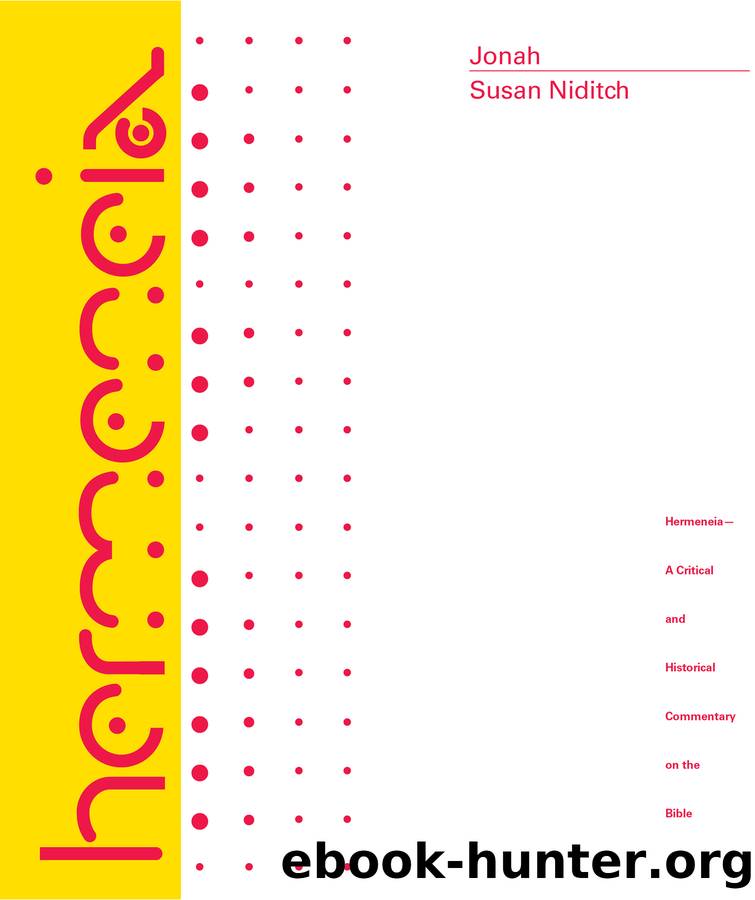Jonah by Susan Niditch

Author:Susan Niditch [Susan Niditch]
Language: eng
Format: epub
Publisher: Fortress Press
Published: 2022-06-15T00:00:00+00:00
Artistic Representations
The artistic cultures of late antiquity and the work of thirteenth- to fifteenth-century European illustrators of sacred books offer two excellent touchpoints for exploring the portrayal in visual media of Jonahâs experience with the fish. Jewish and Christian artists of these creative periods produced objects and settings for the communities well versed in the biblical tale of Jonah and receptive to its illustration and visual retelling. In particular, early Christian artists embraced images of Jonah, whose experience with the fish and under the shade of the planting are among the most common representations in early Christian art.98
Evidence for visual imaginings of Jonah and the fish in late antiquity can be found in various media including mosaics, painted scenes on plaster or frescoes, and carved work. Mosaics featuring Jonah are of special interest in the present study, and appreciation for the medium and the orientation of the artists requires some introduction. Mosaics are constructed from chips of stone or terra-cotta in various natural or glazed colors that are set in a surface layer of mortar resting on base layers of coarse mortar.99 As noted by art historian Roger Ling, the principal function of mosaic pavements was aesthetic, âto enhance the spaces that contained them.â100 He writes, âTiny pieces of different coloured materials, when viewed from a distance, would merge to create gradations and modulations of tone that mimicked the mixing of pigments on a traditional painterâs panel.â101
As to content, Rachel Hachlili points to the theme of salvation implicit in Jewish portrayals of Aaron, Abraham, Daniel, and other biblical heroes and sees such scenes as âsymbolizing traditional historical events, divine intervention, the covenant between God and his chosen people, and his protection of some and his punishment of others.â102 Roger Ling and Hachlili both describe the traditional, formulaic or conventionalized nature of the portrayals and suggest that artisans had at their disposal pattern books.103 Ling mentions a third-century B.C.E. Egyptian papyrus that refers to a pattern sent to a mosaicist at Philadelphia in the Fayum as a âguideâ for his project.104 For all traditional artists working in verbal and nonverbal media, such patterns eventually become âinscribed on the heartâ while being open to individual creative adaptations influenced by personal and local tastes.105 Mosaics could be applied to walls and vaults as well as to pavements, although the latter are far more common due to the cost of applications on high-up surfaces and the dangers involved in this sort of work. In such difficult-to-reach places, paintings or stucco reliefs would be more practical media,106 although one example of a Christian Jonah mosaic does decorate, along with other representations, a fourth-century vault in the mausoleum at Centcelles near Tarragona in Spain.107 The mosaics, Jewish or Christian, are placed in âbuildings of high prestige.â108
Differences in Jewish and Christian orientations may inform, to a degree, the use made of Jonah in late antique settings, in mosaics as well as in other media. Hachlili notes, for example, that Jews employed various biblical scenes in floor mosaics,
Download
This site does not store any files on its server. We only index and link to content provided by other sites. Please contact the content providers to delete copyright contents if any and email us, we'll remove relevant links or contents immediately.
The Five People You Meet in Heaven by Mitch Albom(3456)
Real Sex by Lauren F. Winner(2949)
Name Book, The: Over 10,000 Names--Their Meanings, Origins, and Spiritual Significance by Astoria Dorothy(2925)
The Secret Power of Speaking God's Word by Joyce Meyer(2917)
The Holy Spirit by Billy Graham(2876)
0041152001443424520 .pdf by Unknown(2766)
ESV Study Bible by Crossway(2725)
How The Mind Works by Steven Pinker(2711)
Ancient Worlds by Michael Scott(2607)
The ESV Study Bible by Crossway Bibles(2493)
Churchill by Paul Johnson(2493)
The Meaning of the Library by unknow(2485)
The Gnostic Gospels by Pagels Elaine(2459)
MOSES THE EGYPTIAN by Jan Assmann(2360)
Jesus by Paul Johnson(2294)
City of Stairs by Robert Jackson Bennett(2292)
The Complete Dead Sea Scrolls in English (7th Edition) (Penguin Classics) by Geza Vermes(2222)
Ancient Near Eastern Thought and the Old Testament by John H. Walton(2183)
The Nativity by Geza Vermes(2164)
